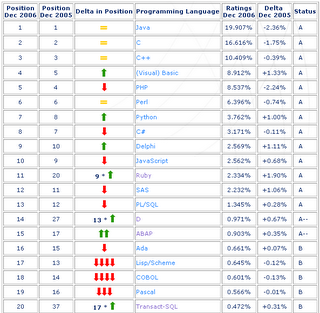Tiobe Index
I stumbled accross the following Programming Community Index, Tiobe which tries to chart the most popular programming languages.

Although the metrics to determine these ratings are discussable, I like to point out a few things :
- The index can be used to make a strategic decision about what programming language should be adopted when starting to build a new software system. Apparently, since Java remains the most popular language, long term projects will not suffer from a shortage of people with programming experience in Java. It may not have the fastest developement cycle or the best performance but it is the safest choice.
- Talking about niche's, the ABAP language is back on his way up. Combining this with the popularity of Java (both are usable within the SAP framework) results in a high demand of ERP/SAP specialists, like a few friends of mine are experiencing.
- Remarkable Ruby: Ruby continues his way up. The hype keeps growing. Since JRuby can easily be integrated in the Java 6 SE VM, it definitely makes sense for Java developers to start learning this programming language. Due to Tiobe, Ruby is the top favorite for the title "Programming language of the year 2006". Poor performance of Ruby remains an issue however.
- The eye catching increase of Transact SQL is unexplainable. The language is available for many years in Microsoft SQL Server. I am forced to use it in my current project and I can hardly hide the fact that I dislike it. It is related to PL/SQL, which also occupies a fairly high ranking.
- The popularity of the D language is sky rocketing. I am a total virgin with this programming language, so I cannot tell anything useful about it. I only took a quick tour at the D website and the language features look pretty low level to me. Due to its name, it claims to be the successor of C(C++). Its performance is great and its increase in popularity is remarkable.
